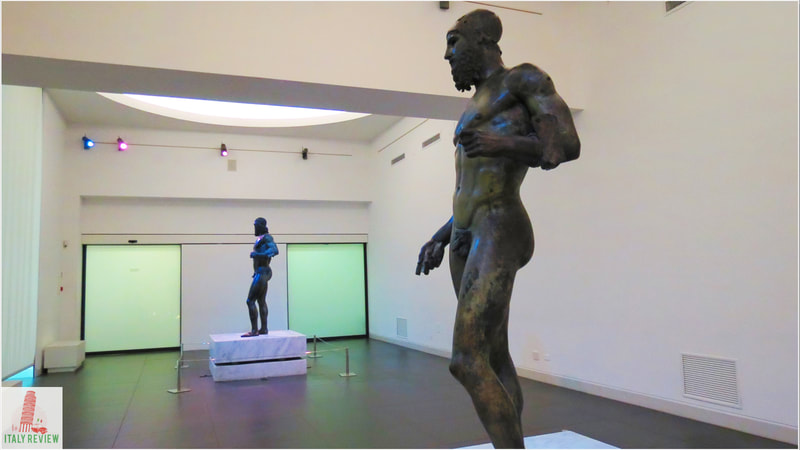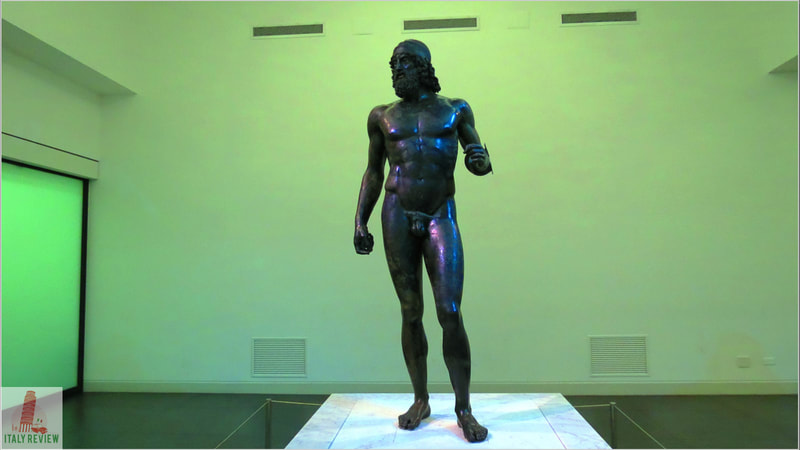Riace Bronzes
|
By Dion Protani
|
Latest update: 15 January 2024
|
|
The Riace Bronzes are two life-size bronze sculptures that have been dated back to around 450 to 460 BC. They were discovered in 1972 by a diver close to the small beach resort of Riace Marina in Calabria, which is where they take their name from.
The two statues are on display in a specially-concealed chamber at the National Museum of Magna Graecia in Reggio Calabria. |
Related links
Profile
The Riace Bronzes, also known as the Riace Warriors, are a pair of ancient Greek bronze statues that represent two heroic male figures. They were discovered in 1972 by a scuba diver off the coast of Riace Marina, a small town in Calabria, Italy.
The statues are considered among the most important examples of Greek bronze sculpture and are now housed in the National Archaeological Museum of Reggio Calabria.
The Riace Bronzes are life-size statues, each depicting a male warrior in a dynamic pose. The statues are made of bronze and are believed to date back to the 5th century BCE, during the Classical period of ancient Greece. The muscular bodies and lifelike details of the sculptures showcase the exceptional skill of the ancient Greek sculptors.
The first warrior, known as "Riace A" or the "Youthful Warrior," is depicted as a young and athletic figure. He wears a helmet adorned with a griffin, and his right arm is raised, possibly holding a spear.
The second warrior, known as "Riace B" or the "Bearded Warrior," is shown with a more mature appearance. His facial expression is intense, and his left arm is raised, possibly holding a shield.
The statues are considered among the most important examples of Greek bronze sculpture and are now housed in the National Archaeological Museum of Reggio Calabria.
The Riace Bronzes are life-size statues, each depicting a male warrior in a dynamic pose. The statues are made of bronze and are believed to date back to the 5th century BCE, during the Classical period of ancient Greece. The muscular bodies and lifelike details of the sculptures showcase the exceptional skill of the ancient Greek sculptors.
The first warrior, known as "Riace A" or the "Youthful Warrior," is depicted as a young and athletic figure. He wears a helmet adorned with a griffin, and his right arm is raised, possibly holding a spear.
The second warrior, known as "Riace B" or the "Bearded Warrior," is shown with a more mature appearance. His facial expression is intense, and his left arm is raised, possibly holding a shield.
History
The Riace Bronzes are believed to have been made by a skilled Greek sculptor or workshop during the 5th century BCE. They were likely created to commemorate victories or as offerings in a sanctuary. However, the exact origin and the sanctuary they once belonged to remain unknown.
The statues were lost at sea after a shipwreck, which likely occurred while transporting them. They lay at the bottom of the sea for centuries until their accidental discovery by the scuba diver Stefano Mariottini in 1972. Following their recovery, the statues underwent extensive restoration and conservation work before being displayed in the National Archaeological Museum of Reggio Calabria.
The statues were lost at sea after a shipwreck, which likely occurred while transporting them. They lay at the bottom of the sea for centuries until their accidental discovery by the scuba diver Stefano Mariottini in 1972. Following their recovery, the statues underwent extensive restoration and conservation work before being displayed in the National Archaeological Museum of Reggio Calabria.
Key features and nearby attractions
- Location: The Riace Bronzes are displayed in the National Archaeological Museum of Reggio Calabria, which is located in the city of Reggio Calabria, about 25 kilometers from Riace Marina.
- Opening Hours: The museum's opening hours may vary, so it's best to check the official website or contact the museum for up-to-date information before planning your visit.
- Entrance Fee: There is an entrance fee to visit the museum, and different rates may apply for various visitor categories, such as students and seniors.
- Guided Tours: Consider joining a guided tour of the museum to gain a deeper understanding of the Riace Bronzes and other ancient artifacts on display.
- Nearby Attractions: While in Reggio Calabria, visitors can explore other historical and cultural attractions, such as the Archaeological Park of Locri Epizephyrii and the Lungomare Falcomatà, a beautiful seafront promenade.
- Photography: Photography is generally allowed inside the museum, but check for any restrictions or guidelines at the entrance.
Bronzi di Riace
|
Location: National Museum of Magna Graecia
City: Reggio Calabria Province: Metropolitan City of Reggio Calabria Region: Calabria Created: 450 - 460 BC Close by: Scilla, Chianalea, Aspromonte National Park, Bova Recommended accommodation: Hotel Continental |























